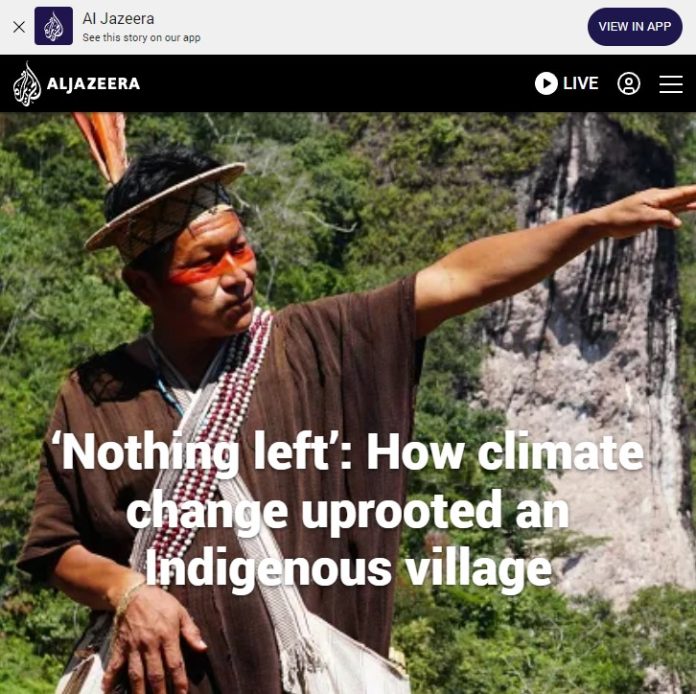An article by Al Jazeera claims climate change is wreaking havoc in the lives of the San Miguel Centro Marankiari indigenous peoples of the Ashaninka village in the mountains of central Peru. This is false. Climate change is a red herring. Data and historical evidence show that neither temperatures or rainfall/drought conditions in the region are outside its historical norm. Also, the story itself makes it clear that incursions from farmers outside of the Marankiari community, who are deforesting the mountain slopes. are disrupting the traditional lives of Marankiari, neither of which are being driven by climate change, though they both can affect the local climate.
Based on the headline, “‘Nothing left’: How climate change uprooted an Indigenous village,” Al Jazeera’s story is misleading from the beginning – although it does detail some serious issues facing the native Marankiari people.
First, the story spends almost no time at all detailing the problems “climate change” is supposedly causing for the lives of the Marankiari, rather it vaguely references drought as a problem, but doesn’t provide evidence of a long-term trend. Perhaps, because there is none. Second, the story’s headline indicates that that Ashaninka has been “uprooted,” but, in fact, as the story reveals, current conditions are causing the tribe’s leader, Tsitsiri Samaniego, to consider whether “Migration, . . . might be his community’s best option.
“But leaving his homeland is a last resort — a complicated decision born of circumstances beyond his control,” writes Al Jazeera.
To be clear, belying Al Jazeera’s headline, because the village is still located where it has existed for generations, it has not, in fact, been “uprooted.” It may move at some point in the future, but it also may not.
Concerning climate change, the story references the World Bank’s claiming that climate change is one factor among many facing indigenous people around the world.
“In Latin America today, nearly half of all Indigenous peoples have migrated to urban areas due to land degradation, territorial dispossession, climate change, and conflict, according to the World Bank,” says Al Jazeera, playing up climate change in the headline, while ignoring the other factors, two of which, in particular, the actual story discusses as length.
Looking at the climate factors in Peru, one finds there is no trend in worsening drought or heat there. According to World Data, the hottest summer from December to February, in Peru below 2,540 meters altitude, was recorded in 1998, 26 years of global warming ago. The coldest winter in Peru in 75 years was recorded in 1974, but the coldest single day at the Tacna weather station was in July 2010, well withing the recent period of purported dangerous global warming.
Drought has been common throughout Peru’s history. The highly complex Wari empire, which had developed an extensive water system to mitigate the naturally arid conditions in parts of Peru, eventually succumbed to a long-term severe drought more than 1,000 years ago. Many of the historical droughts are tied to El Nino events. Other serious drought events occurred during the late-18th and early 19th century, and again in the early 1930s. Some regions of Peru experience drought with regularity, with “two meteorological stations in Puno hav[ing] registered an annual drought frequency of 18 percent in one and 35 percent in the other.”
In fact, “[w]ith a total of 5.20 rainy days, it rained more often in December 2023 than it has in the same month for 12 years (5.90 days in 2011) [and] [w]ith 3.92 liters of precipitation in 2023, April was the wettest in 40 years (6.27 l/m² in 1983),” reports World Data.
The point being, swings in climate extremes of drought and heavy rainfall have been common throughout Peru’s history. Current conditions are not unusual.
Of course, the mountain peaks where Ashaninka is located may be experiencing less rainfall than other parts of the country, but climate change isn’t picky, causing rain on this mountain and village, not the next one, it is global phenomenon with regionwide affects.
Even with recent good rains Ashaninika might still be seeing less rainfall than other locations in the Peruvian Andes, but if so, the reason is not climate change but rather other more direct and immediate causes that Al Jazeera itself spends time writing about: massive deforestation, which reduces local humidity, with said deforestation being driven by, “settlers from the high Andes escaping poverty, who are steadily absorbing territory occupied by the Ashaninka for generations.”
“The incoming farmers have razed much of the humid rainforest near the village to plant groves of citrus, avocado, and coffee. That, in turn, has altered the local rain cycles, bringing extreme heat and drought to San Miguel Centro Marankiari,” Al Jazeera states. “The result has been the desiccation of his community’s cassava and plantain crops, Samaniego explains. Food and clean water have become scarce. And tensions with the neighbouring landowners have soared.”
So, deforestation and invasive farmers are causing the Marankiari’s woes, not climate change.
While Al Jazeera’s article detailing the plight of the San Miguel Centro Marankiari is a great human-interest story, it is not one about the dangers of climate change. The problems they face aren’t caused by global carbon dioxide emissions, but rather something much more local and manageable. With this being the case, why did Al Jazeera feel the need to tie the plight of the Marankiai and their Ashaninika village to climate change? Perhaps to garner eyes on the story and clicks online, but it certainly does not reflect the truth or serve as an example of honest journalism.

















